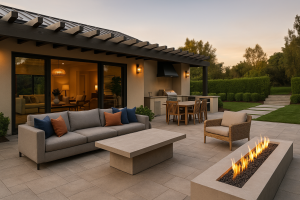When it comes to selecting a range hood for your kitchen, there are a number of important factors to consider. From size and ventilation requirements to noise levels and design, choosing the right range hood can make a significant difference in the efficiency and overall aesthetic of your kitchen.
In this guide, we will explore the 10 key things you need to consider when buying a range hood. We will provide expert insights and tips on each of these factors to help you make an informed decision and select the perfect range hood for your specific needs.
Whether you’re a seasoned chef or a beginner cook, this guide is designed to provide you with a comprehensive overview of everything you need to know about range hoods. So, let’s dive in and discover the 10 things to consider when buying a range hood.
Range Hood Size Considerations
Choosing the right size range hood is crucial for efficient ventilation and aesthetic appeal in your kitchen. Several factors affect the size of the range hood you need, including your cooktop size, kitchen layout, and ventilation needs.
Cooktop Size
The size of your cooktop should determine the size of the range hood you need. In general, the range hood should be at least as wide as your cooktop. Additionally, the hood should be mounted at a height that allows for effective smoke and odor capture, typically around 30-36 inches above the cooktop surface.
Kitchen Layout
Your kitchen layout can also impact the size of your range hood. If you have a small kitchen, a compact range hood may be a better fit. Alternatively, larger kitchens may benefit from wider, more substantial range hoods that can handle higher volumes of cooking smoke and odors.
Ventilation Needs
Lastly, your ventilation needs are a crucial consideration when selecting a range hood size. If you cook frequently, you may need a larger hood that can handle your cooking volume. Alternatively, if you have an open concept kitchen, you may need a larger hood that can effectively capture and remove smoke and odors from the entire space.
Range Hood Ventilation Requirements
Selecting the right ventilation type for your range hood is crucial for maintaining good air quality in your kitchen. There are two main types of ventilation systems: ducted and ductless.
Ducted Range Hoods
Ducted range hoods require a duct system to remove the contaminants from the kitchen and exhaust them outside. This type of ventilation system is more effective in removing smoke, steam, and other pollutants from the air, as it vents it outside rather than recirculating it.
When considering a ducted range hood, make sure to check for compatibility with your kitchen’s ductwork and the distance of the duct from the kitchen. A range hood that is too far from the duct may require a longer ductwork, which can negatively impact its performance.
Ductless Range Hoods
Ductless range hoods, on the other hand, use filters to remove contaminants from the air before recirculating it back into the kitchen. While not as effective in removing smoke and other pollutants from the air, ductless range hoods are easier to install and can be more cost-effective since they do not require ductwork.
When selecting a ductless range hood, it is important to choose one with high-quality filters that can effectively remove contaminants from the air. Some ductless range hoods also come with optional carbon filters that can help reduce odors in the kitchen.
| Ventilation Type | Pros | Cons |
|---|---|---|
| Ducted | – More effective in removing pollutants – Can be customized to fit the kitchen’s ductwork – Quieter operation |
– May require additional ductwork – Can be more expensive to install |
| Ductless | – Easier to install – More cost-effective – No ductwork required |
– Less effective in removing pollutants – Requires high-quality filters – Louder operation |
Range Hood Noise Levels
When shopping for a range hood, it’s important to consider the noise levels produced by the unit. A loud range hood can be disruptive when cooking, especially in an open-concept kitchen or if you frequently entertain guests. Here are some factors that can affect the noise level of a range hood:
- Fan speed: Generally, the higher the fan speed, the louder the range hood will be. Look for a range hood with variable fan speeds so you can adjust the noise level to your preference.
- Motor type: A range hood with a centrifugal motor will generally be quieter than one with a axial motor.
- Ducted or ductless installation: Ducted range hoods tend to be quieter than ductless ones, as the noise from the motor is carried outside the home instead of being recirculated into the kitchen.
When selecting a range hood, look for models with a sone rating of 6 or lower. A sone is a unit of measurement that describes the perceived loudness of a sound, with 1 sone being equivalent to the sound of a refrigerator running. Keep in mind that range hood noise levels can also depend on the size and layout of your kitchen, so it’s a good idea to test out the unit before purchasing it.
Range Hood Installation Tips
Installing a range hood requires careful planning and execution, as it is a crucial element of any kitchen’s ventilation system. Here are some tips to ensure a smooth and successful installation process:
1. Proper Height
Make sure to install your range hood at the appropriate height above your cooktop. Generally, it should be positioned between 24 and 36 inches from the cooktop surface. Refer to the manufacturer’s instructions for specific guidelines.
2. Electrical Requirements
Ensure that you have the proper electrical outlet or wiring in place for the range hood before installation. If you are not comfortable with electrical work, consult a licensed electrician to assist with installation.
3. Ductwork
If you are installing a ducted range hood, make sure that the ductwork is properly sized and installed. The ductwork should be as short and straight as possible to ensure optimal ventilation efficiency.
4. Codes and Regulations
Check your local building codes and regulations for any specific guidelines or restrictions regarding range hood installation. This will ensure that your installation is safe and compliant.
5. DIY vs. Professional Installation
While it is possible to install a range hood yourself, it can be a complex process. If you are not confident in your DIY skills, it is best to hire a professional to handle the installation for you.
By following these tips, you can ensure that your range hood installation is successful and that your kitchen is properly ventilated.
Range Hood Maintenance Guide
Regular maintenance is crucial to ensure the longevity and optimal performance of your range hood.
Cleaning Techniques
Cleaning your range hood is an important part of maintenance. Here are some tips:
- Turn off the range hood and unplug it
- Remove the filters and soak them in warm, soapy water for about 10 minutes
- Use a soft brush or cloth to clean the filters
- Clean the hood interior with warm, soapy water and a soft cloth
- Dry the filters and hood interior thoroughly before replacing the filters
Filter Replacement
It’s important to replace the filters in your range hood regularly. Here are some general guidelines for filter replacement:
| Filter Type | Frequency of Replacement |
|---|---|
| Charcoal Filter | Every 6 months to 1 year |
| Aluminum Mesh Filter | Every 2 to 3 months |
General Upkeep
In addition to cleaning and filter replacement, there are some general maintenance tasks you can do to keep your range hood functioning at its best:
- Check for any loose or damaged parts and replace them as necessary
- Make sure the fan and motor are functioning properly
- Check the ductwork for any blockages or damage
- Inspect the range hood regularly to ensure it is working as it should
By following these tips and guidelines, you can ensure that your range hood is clean, functioning properly, and operating at its best.
Range Hood Styles and Designs
Range hoods are more than just functional appliances, they can also be a stylish addition to your kitchen decor. When choosing a range hood, it’s important to consider the overall design and style of your kitchen to ensure a cohesive look. Here are some popular range hood styles to consider:
| Style | Description |
|---|---|
| Under-cabinet | This type of range hood is mounted underneath the kitchen cabinet, above the stove. It’s a popular choice for homeowners looking for an unobtrusive option that doesn’t take up too much space. |
| Wall-mounted | Mounted on the wall above the stove, this type of range hood is a statement piece that can add a touch of elegance to your kitchen. They are available in a variety of materials and finishes to match your kitchen design. |
| Island | If your stove is located on an island in the kitchen, an island range hood is the perfect choice. They are mounted to the ceiling and provide ventilation from above. Island range hoods are available in a variety of styles and finishes to match your kitchen decor. |
When choosing a range hood, it’s important to consider the size and layout of your kitchen, as well as your personal style preferences. Whether you prefer a sleek and modern look or a more traditional design, there’s a range hood style to suit your needs.
Range Hood Energy Efficiency
When choosing a range hood, energy efficiency should be a key consideration. Not only does an energy-efficient range hood help reduce your carbon footprint, but it can also save you money on energy bills over time. Here are some tips for selecting an energy-efficient range hood:
- Look for ENERGY STAR certified models: These range hoods meet strict energy efficiency guidelines set by the U.S. Environmental Protection Agency. They use up to 65% less energy than standard models and can save you hundreds of dollars over the hood’s lifetime.
- Consider fan speed: Choose a range hood with variable fan speeds, allowing you to adjust the fan based on the cooking task. Lower fan speeds use less energy.
- Opt for LED lighting: LED lights are energy-efficient and can last up to 25 times longer than traditional bulbs.
- Maintain your range hood: Keeping your range hood clean and replacing filters as needed can ensure that it continues to operate at optimal efficiency.
- Choose a size that matches your cooktop: A range hood that is too small for your cooktop may need to run on a higher fan speed, which uses more energy. Selecting the appropriate size for your cooktop can help reduce energy usage.
- Consider ducted vs. ductless: While ductless range hoods may be more convenient to install, ducted range hoods are often more energy-efficient as they remove cooking pollutants directly outside.
FAQ – Frequently Asked Questions
Here are some common questions related to buying and installing range hoods:
1. What size range hood do I need?
The size of your range hood should match the size of your cooktop. As a general rule, your range hood should be at least as wide as your cooktop. If you have a large cooktop or a kitchen with high ceilings, you may need a larger range hood to ensure adequate ventilation.
2. What type of ventilation system should I choose?
This largely depends on the layout of your kitchen. If you have the ability to vent your range hood outside, a ducted installation is highly recommended as it provides the most effective ventilation. However, if you are unable to vent outside, a ductless range hood can still offer decent ventilation but may require more frequent filter replacements.
3. How loud will my range hood be?
The noise level of a range hood depends on factors such as fan speed and motor type. If you prefer a quieter range hood, look for models with lower sones ratings. As a general rule, a range hood with a sones rating of 6 or less is considered quiet.
4. Can I install the range hood myself?
While it’s possible to install a range hood yourself, it’s recommended that you hire a professional to ensure proper installation and adherence to local codes and regulations.
5. How do I maintain my range hood?
Regular maintenance is important to keep your range hood functioning properly. This includes cleaning the exterior and interior of the hood, replacing filters as needed, and checking for any damage or wear and tear.
6. What styles of range hoods are available?
There are many styles of range hoods available, including under-cabinet, wall-mounted, and island hoods. Choose a style that complements your kitchen’s design and layout.
7. How can I ensure my range hood is energy efficient?
Look for range hoods with energy-saving features such as LED lighting and variable fan speeds. Additionally, choose a range hood that is appropriately sized for your cooktop to ensure maximum efficiency.










